Pest plants damage native Australian fauna and flora, can diminish land value, threaten agriculture, community economies and can cause health problems. The Sunshine Coast is one of the most biologically rich areas of Australia with large areas of remnant bush under the management of private landholders.
Approximately 11,681ha of protected national park (Kondalilla, Mapleton Falls and Mapleton National Parks) surround Mapleton and Flaxton. Additional environmental protection within the area is provided by private landholders who have put parts of their property under private voluntary protection covenants known as ‘Voluntary Conservation Areas or Agreements’ (VCAs). These are covenants between a landholder and the Sunshine Coast Regional Council that commits the land holder to active protection, conservation, and management of a specified part of their land. A further percentage of private land is covered by ‘Land for Wildlife’ (referred to as LfW) programs. Land for Wildlife is a voluntary program that encourages and assists landholders to manage wildlife habitat on their properties. Land for Wildlife arrangements integrate nature conservation with residential or other uses.
Accessing conservation activities can be a challenge. We can’t all afford a property to look after, many of us don’t have the physical ability, and those of us who are time poor are limited in how much we can dedicate to getting involved in local efforts, so the care of our environment can appear to be the responsibility of a limited few. The ‘Gardens for Wildlife’ provides a pathway for all of us to look after nature from the comfort of our own block, home garden or even our tiny urban balcony!
Every property matters, and everyone can get involved.
Because so many landholders and the council are trying to conserve and/or improve the native environment for all of us, it is incumbent on our community to be aware of and contribute to plant control by managing invasive plants on our properties.
Click for more information about VCAs.
Click for more information about LfWs.
Click for more information about Gardens for Wildlife.
Click for information about Queensland Conservation Council

The Indian Myna: A Complex Tale in Southeast Queensland
Our feathered neighbours: Southeast Queensland is home to a diverse array of birds, each with their own unique story. The Noisy Miner, a native nectar-feeder, and the Indian Myna, an introduced species, often share the same space, leading to complex interactions.
More than just colour: While both birds are roughly the same size, their appearances differ greatly. The Noisy Miner sports a predominantly grey plumage, while the Indian Myna stands out with its chocolate-brown body and black head. Both species are known for their assertive nature, with the Noisy Miner fiercely defending its nectar sources and the Indian Myna competing for nesting sites.
A guest with unintended consequences: The Indian Myna, originally introduced to combat pests in Melbourne and then in North Queensland, has become a cause for concern. Released in the late 19th century, it has established itself in many urban areas. Its fondness for fruit and seedlings makes it a nuisance to farmers and gardeners, and its aggressive behaviour can displace native birds. The Indian Myna is not a restricted invasive animal under the Queensland Biosecurity Act, but is identified as a priority species in its biosecurity plan.
A closer look at their habits: Indian Mynas are opportunistic feeders, enjoying a varied diet of insects, fruits, scraps, and even other birds’ young. They thrive near human settlements, often roosting in large groups in buildings, bridges, and trees during the non-breeding season. Indian Mynas threaten native biodiversity with their territorial behaviour. They compete with native animals for nesting hollows, aggressively defending their territory. They are also thought to evict native species, such as parrots and gliders, from their hollows and even kill their young.
Family life with a twist: These birds mate for life and compete fiercely for nesting sites, often favouring convenient locations in buildings, much to the chagrin of humans. Their messy nests, built with leaves, grasses, and even rubbish, can cause problems.
Controlling the population: A delicate balance: While the Indian Myna is considered a pest in some areas, its population control is a complex issue. The RSPCA advises against community-led culling and suggests focusing on improving natural habitats to promote bird diversity. However, if control is necessary, it should be conducted humanely and under government supervision, with careful monitoring of its impact.
Under the Biosecurity Act all Queenslanders have a general biosecurity obligation to manage Indian mynas on their land. You can report Indian myna bird sightings using MynaScan.
Understanding our feathered neighbours: By learning about the Indian Myna and its interactions with native species, we can make informed decisions about managing its population and fostering a harmonious environment for all birds in Southeast Queensland.
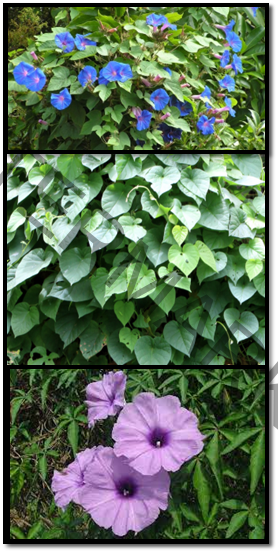
Weed of the month: January
Morning Glory. Ipomoea indica, Ipomoea cairica, and Ipomoea alba
Common Name(s): Mile a minute, Messina creeper.
Morning Glory is a rampant climber/creeper. It has very distinctive leaves have 5-7 finger-like lobes. Its large purple, purplish-pink or whitish tubular flowers (around 4-6 cm long and 5-8 cm across) have a darker centre its small capsules (10-12 mm across) turn brown as they mature and contain four seeds. These seed are partly covered in long silky hairs. The flowers are funnel shaped. Morning Glory will flower for most of the year. New flowers open daily and will fade from blue to pink.
Morning glory (Ipomoea) is a significant environmental weed in Queensland. This species is capable of very rapid growth and can completely smother native trees and understorey plants, but it will creep along the ground and form dense mats over the ground in the absence of supporting vegetation. Significant infestations may lead to a reduction in biodiversity through the replacement of native vegetation and the displacement of certain native animals. It is particularly common in the coastal districts of eastern Australia, where it often invades riverbanks and riparian vegetation. It also commonly invades rainforest margins, where it grows over larger trees and smothers tree saplings and understorey shrubs and is a major problem in littoral rainforest remnants. However, it is also a weed of sandy beachfronts and other coastal environments, drier forests, wetlands, and limestone cliffs. Morning glory is ranked among the top 30 environmental weeds in south-eastern Queensland.
This species is actively managed by community groups in Queensland and appears on numerous local environmental weed lists. It will reproduce from broken fragments of stem. The most common form of dispersal is from gardeners/property owners dumping unwanted vegetive material. Heavy growths of Morning Glory occur where original forest has been destroyed or fragmented by human activity. Some of the largest infestations in Queensland occur on the Blackall Range hillsides Mapleton to Maleny.
Morning Glory can be removed manually by digging the crown and roots to prevent regrowth. Herbicides are effective on large infestations. Whilst Morning Glory is not a restricted invasive plant under the Biosecurity Act 2014, everyone has a legal responsibility to take reasonable and practical steps to minims the risks of invasive plants under their control.
Click for more information about Morning Glory.
Click for more information about invasive plants and animals.
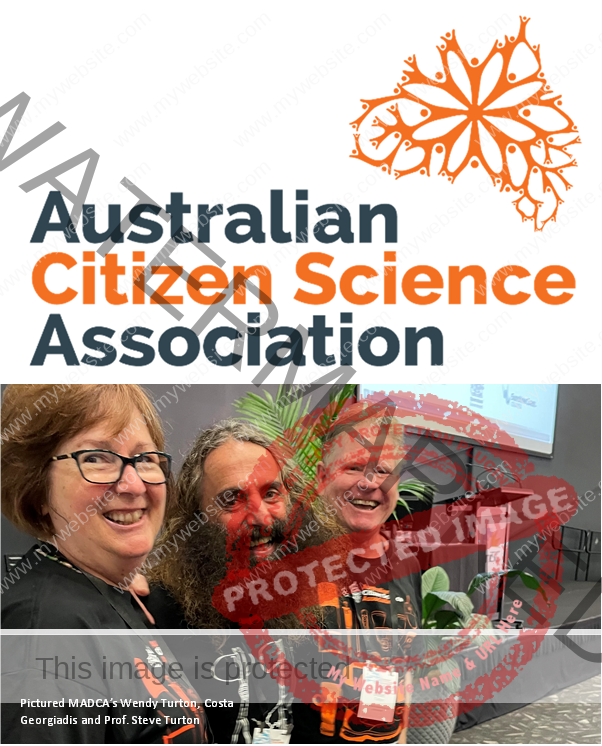
Australian Citizen Science Conference
Mapleton-based resident, Professor Steve Turton, Vice Chair of the Australian Citizen Science Association (ACSA) was the conference co-convenor. Prof. Turton worked with a Queensland-based local organising committee to deliver a very successful conference at the University of the Sunshine Coast, the Gold Sponsor for the event.
Citizen science is the collection and analysis of scientific data in relation to the natural world, performed predominantly by citizens, usually in collaboration with scientists and field experts. Citizen scientists work with scientists or the scientific framework to achieve scientific goals. Citizen science is a great way to harness community skills and passion to fuel the capacity of science to answer our questions about the world and how it works. The 10 Principles of Citizen Science provide an overview of its many benefits to the environment and society, including health and wellbeing.
The Australian Citizen Science Association (ACSA) is member-based incorporated association that seeks to advance citizen science through the sharing of knowledge, collaboration, capacity building and advocacy.
ACSA was first conceived in 2014 when many dedicated volunteers came together to discuss how to increase awareness and support of Australian citizen science both nationally and globally.
ACSA’s biennial national conference was held at the University of the Sunshine Coast (Sippy Downs Campus) from 20-23 November 2023. About 200 delegates from Australia and overseas participated in the four-day event that included workshops, field trips, plenary keynotes and breakout sessions. The conference theme was “Inspire, Impact and Influence”. The Friday after the conference witnessed the launch of the first day of the Great Southern BioBlitz 2023.
Highlights from the conference included informative keynote speeches from Dr Fiona Fraser (Threatened Species Commissioner), Professor Kerrie Wilson (Queensland Chief Scientist), Andy Ridley (CEO of Citizens of the Great Barrier Reef), Associate Professor Kathy Townsend (University of the Sunshine Coast), Margaret Gold (Citizen Science Lab, Leiden University, The Netherlands), and Costa Georgiadis (Landscape Architect, Environmental Educator, TV Presenter).
A diverse range of parallel and symposia sessions were held showcasing the diversity of citizen science initiatives being undertaken across the country. These included conservation and biodiversity, citizens science practice, collaboration and co-creation, citizen science in schools and education, communication and public engagement, citizen science in gardens and backyard, ecosystems, waterways, and climate change.
A locally focussed symposium on “BioBlitzes” included speakers from Nambour-based ECOllaboration, Sunshine Coast Environment Council, Mooloolah River Landcare, Sunshine Coast Council, Noosa and District Landcare, and Barung Landcare.
The following is a short list of projects that may interest our readers and offer a forum to share interest in science.
Koala App
If you see a wild koala in Queensland, report it to the Department of Environment and Science by using the free QWildlife app for iOS and Android. The Koala app is useful to have on your phone as a means of assisting protection of our koalas. Report sightings, especially of injured koalas in need of assistance.
Queensland Government Koala App
FrogID
The Australian Museum FrodID App. This initiative has excellent online support and is a
project for all ages. Simply download the App, register, start recording and submit your
recording. You will receive a list of the frogs identified and details about them including
their conservation status.
Australian Museum – FrogId
The iNaturalist Australia app contributes to the Atlas of Living Australia. The Atlas of Living Australia (ALA) is a collaborative, digital, open infrastructure that pulls together Australian biodiversity data from multiple sources, making it accessible and reusable. You can learn more at ALA website.
Atlas of Living Australia
Click for more information about the Australian Citizen Science Association
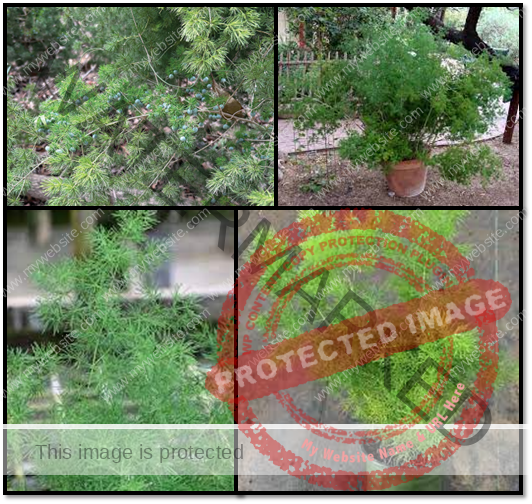
Weed of the Month: December
Ming Asparagus Fern
Common name(s): Pom pom asparagus, Zig zag asparagus.
The Sunshine Coast is known for its stunning beaches, lush rainforests, and vibrant gardens. But hidden amongst the beauty lurks a sneaky invader: the Ming asparagus fern. This seemingly delicate plant, with its cascading sprays of feathery foliage, is a declared weed with the potential to wreak havoc on our native ecosystems.
Identification:
• Shrubby appearance: Unlike true ferns, the Ming asparagus fern grows upright, reaching 1-3 meters in height. It has a woody base and scrambles over other plants.
• Fern-like foliage: Instead of broad leaves, the Ming asparagus fern boasts a mass of needle-like cladodes (modified stems) that emerge in whorls from its branches. These can be green, blue-green, or even reddish depending on the variety.
• Tiny red berries: In late summer, the Ming asparagus fern produces clusters of bright red berries, adding to its deceptive charm.
The Ming asparagus fern hails from South Africa, where it thrives in coastal areas. Unfortunately, its ornamental appeal has led to its introduction to other regions, including Australia, where it has escaped gardens and become a serious environmental threat.
The Ming asparagus fern’s dense growth smothers native vegetation, preventing them from accessing sunlight and nutrients. It can also alter soil chemistry and disrupt natural ecological processes. In some areas, it has even formed impenetrable thickets, impacting native wildlife and hindering access to beaches and waterways.
Controlling the Ming asparagus fern requires a multi-pronged approach. Regularly check your garden and surrounding areas for signs of the Ming asparagus fern. If you find it, remove it promptly, including all roots, and dispose of it responsibly (not in your compost bin). Herbicides can be effective for larger infestations, but it’s crucial to choose products specifically targeted for the Ming asparagus fern and follow application instructions carefully to avoid harming native plants.
Educating residents and gardeners about the Ming asparagus fern’s dangers is essential for preventing its spread. Share information about its identification and control methods with your neighbours and community groups.
By working together, we can combat the Ming asparagus fern and protect the Sunshine Coast’s precious natural beauty. Remember, even a single escaped plant can become a major problem, so vigilance is key. Let’s keep our gardens and our environment free from this beautiful but invasive threat.
Additional tips:
Consider planting native species in your garden, as they are naturally adapted to the local environment and can help resist weed invasion. Support local conservation efforts and initiatives aimed at controlling invasive species. Report any sightings of the Ming asparagus fern to your local council or biosecurity department.
Together, we can ensure the Sunshine Coast remains a haven for native plants and wildlife for generations to come.
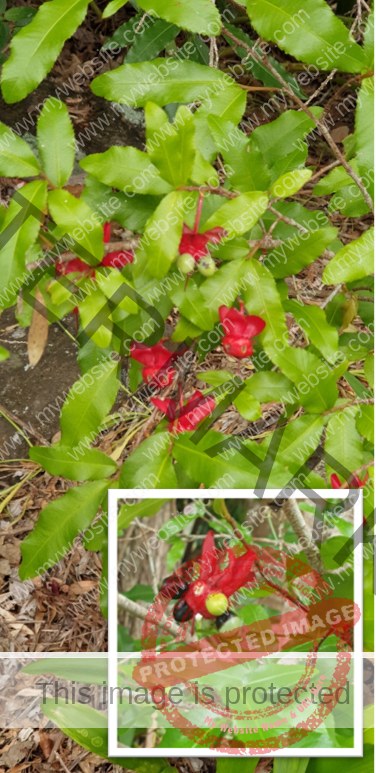
Weed of the Month: November
Ochna. Ochna serrulata
Common name(s): Mickey mouse plant, Bird’s eye bush, Carnival bush.
Ochna is a significant environmental weed in Queensland. Introduced in the 1900s, it is often grown in Southeast Queensland gardens because it is ‘pretty’. It is listed as a priority invasive species for our region.
Ochna is a native of Southern Africa which flowers between spring and summer. It is a shrub which can grow to 3m high. It has bright yellow flowers with 5 petals in winter and shiny oblong elliptical leaves with toothed edges. The shrub has green fruit which darken to black surrounded by bright red sepals or petal-like structures. It is a garden escapee and has invaded rain forest, dry sclerophyll forest, riparian areas, and roadsides. It has been spread by seed dropped by birds, transported on vehicle wheels and garden waste being dumped in bushland.
Ochna has a tough, kinked root that snaps off, leaving the taproot in the ground to re-grow. When Ochnas are too difficult to pull out, the most effective way to control them is to “scrape and paint” the stem with herbicide.

Weed of the Month: October
Black-eyed Susan. Thunbergia alata
Common name(s): Black-eyed Susan
October
Thunbergia alata
Common name(s): Black-eyed Susan
Black-eyed Susan (Thunbergia alata) is regarded as an environmental weed of waterways, urban bushland, forest margins, roadsides and waste areas, in New South Wales and Queensland.
Black-eyed Susan is a species of Thunbergia, which are vigorous, perennial, twining vines native to northern India and tropical Africa. It has been promoted by the nursery industry as a popular choice when a quick coverage is desired. However, it is an invasive weed in Queensland and the Sunshine Coast.
The flowers are borne singly in the upper leaf forks on stalks 30-95 mm long. These tubular flowers (3-4 cm wide) are predominantly orange or yellow with a black throat. There are two leafy bracts at the base of each flower. Their petals are fused into a tube 15-25 mm long with five spreading petal lobes (10-15 mm long). Each flower also has four stamens and an ovary topped with a style and stigma. Flowering occurs throughout the year but is most abundant during spring and summer.
Reasons why it is an invasive weed in Queensland:
Fast growth: Black-eyed Susan is a long-lived vine that can grow up to 5 meters in height. It has slender stems that are green and hairy when young, and paired leaves that are borne on stalks up to 10 cm long. This fast growth allows it to outcompete native plants and take over natural habitats.
Seed production: Black-eyed Susan produces large numbers of seeds that can be dispersed over long distances by wind, water, and animals. This allows it to spread rapidly and establish new populations in areas where it is not native.
Lack of natural predators: Black-eyed Susan has no natural predators in Queensland and the Sunshine Coast, which allows it to grow unchecked and outcompete native plants.
Tolerance to a range of conditions: Black-eyed Susan is tolerant of a wide range of soil types and environmental conditions, which allows it to grow in a variety of habitats. This makes it difficult to control and eradicate.
To prevent the spread of black-eyed Susan, it is important to avoid planting it in gardens and to remove it from natural areas where it has become established
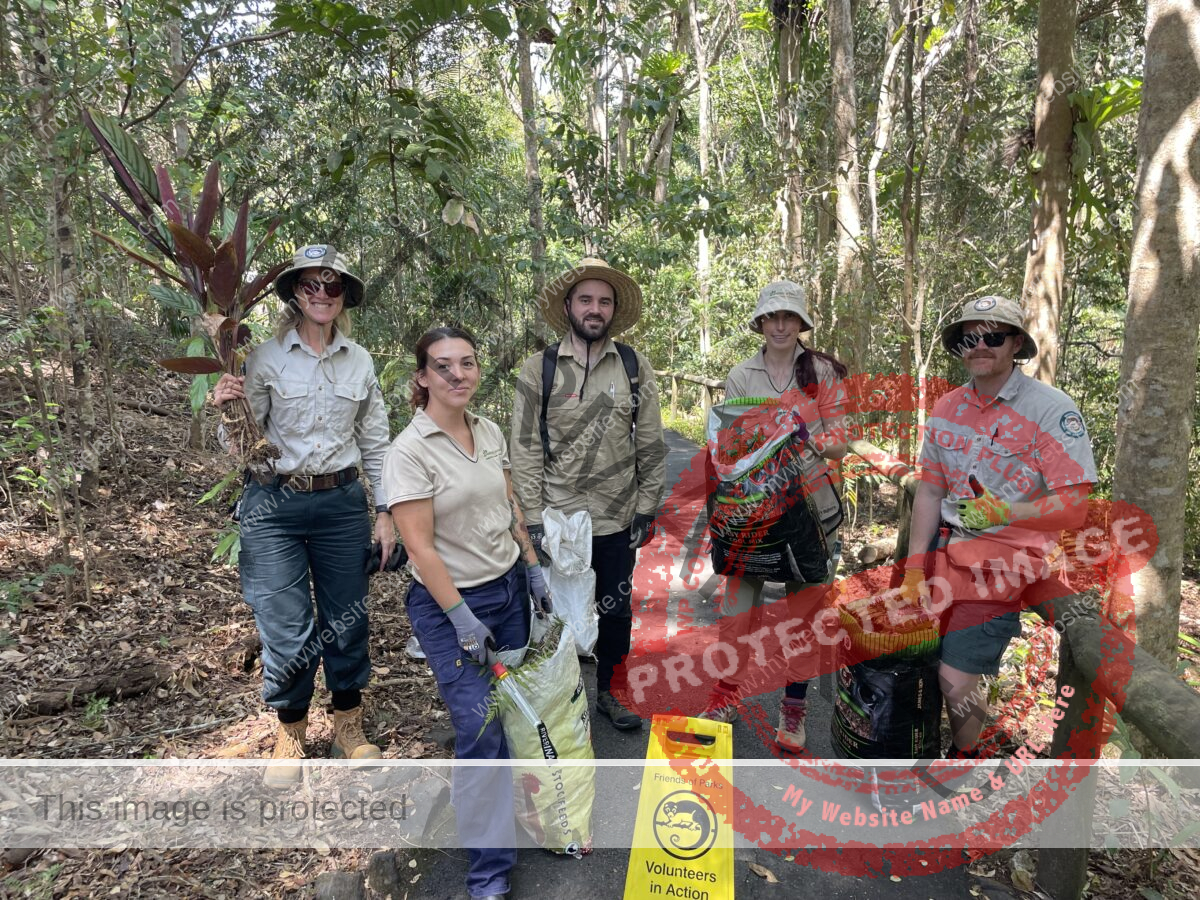
Friends of Parks – Kondalilla
The ‘Friends of Parks – Kondalilla’ volunteers assist local Rangers with a variety of activities that will benefit this much-loved national park.
Volunteers be assist with:
- manual removal of weeds such as exotic pine wildlings and various garden escapees
- minor maintenance and repairs to the walking track
- Maintenance tasks including oiling of picnic tables, painting orientation signs
- native revegetation and planting
- rubbish collection
- recording of fauna and flora observations, and more
As a volunteer, you can expect to:
- make connections with like-minded people and other local environmental groups;
- learn about the different ecosystems and identify native and invasive species that exist within the park;
- gain hands-on experience with safe work methods and best practice environmental management and trail building techniques;
- enjoy being active outdoors and feel good about helping the environment;
- meet local QPWS Rangers who manage these areas.
All tools, equipment and materials will be supplied and there is no prior experience necessary to join.
There are future plans to extend the volunteer group to include Mapleton Falls & Mapleton National Parks.
When is it?
Events run monthly on the second Wednesday of each month from 8am – 11am.
To register your interest and find more, please email the Rangers at: qpwsandp.blackall@des.qld.gov.au

Weed of the Month: September
African Tulip Tree. Spathodea campanulata
Common name(s): African Tulip Tree
The African Tulip Tree (Spathodea campanulata) is an invasive species in Coastal Queensland that has a negative impact on the environment and native species.
Effects on Native Bees
African Tulip Tree is not a preferred food source for native bees, and its nectar and pollen are of low nutritional value. The tree’s flowers are large and showy, but they are not adapted to the feeding habits of native bees, which prefer smaller flowers with a high nectar concentration. As a result, African Tulip Tree can reduce the availability of high-quality food sources for native bees, which can impact their health and reproduction.
Effects on Other Species
African Tulip Tree is highly invasive and can outcompete native vegetation, reducing biodiversity and impacting agricultural production. The tree grows rapidly and forms dense stands in gullies and along streams, crowding out other plant species and altering the habitat. The tree’s ability to resprout after cutting and produce numerous wind-dispersed seeds allows it to spread quickly and contaminate other potted plants and float on water.
Eradication Methods
Physical Control: Physical removal is difficult, as African Tulip Tree coppices vigorously after cutting. Cut mature trees and repeat as needed.
Herbicides specifically labelled for African Tulip Tree control can be used. It is important to follow the instructions on the label and apply the herbicide when the plant is actively growing.
The African Tulip Tree is a highly invasive weed, and its removal should be done responsibly to prevent further spread and damage to the environment.
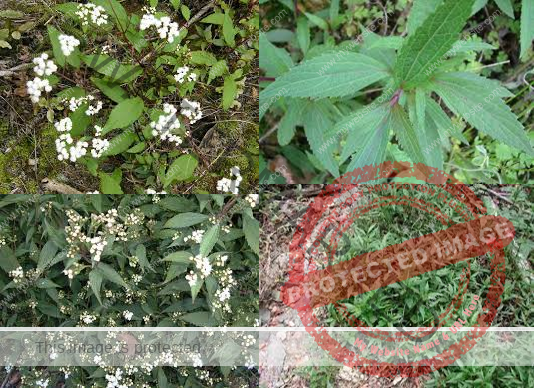
Weed of the Month: August
Mist Flower. Ageratina riparia
Common name(s): Mist Flower, Catspaw, Creeping crofton weed, River eupatorium, Small crofton weed, White weed.
Mist flower (Ageratina riparia) is a low-growing, sprawling perennial herb that thrives in certain conditions. Mist Flower is a sprawling, low-growing perennial herb (40-60cm tall). Stems have roots at joints that touch ground. Leaves are opposite, generally 7.5cm long and 2.5cm wide, toothed along edges, tapered at each end. Flowers are small, white. Branches end with dense heads. Its seeds are black, slender, angular, 2mm long, with fine white hairs at tip.
Conditions for Growth
Mist flower is commonly found in south-eastern Queensland and the Eastern United States. It prefers moist, fertile soils and can tolerate both full sun and partial shade. It is often found in disturbed areas such as pastures, roadsides, and along waterways.
Problems Caused
Mist flower is considered a highly aggressive weed in south-eastern Queensland and is listed among the top 25 most invasive weed species in the region. It competes with native vegetation and pastures, reducing biodiversity and productivity. Its ability to produce roots at the joints where the stems touch the ground allows it to spread rapidly and form dense colonies.
Removal Methods
Manual Removal: Small infestations can be hand-pulled or dug out, ensuring that all roots are removed to prevent regrowth.
Herbicides: In larger infestations, herbicides can be used. It is important to follow the instructions on the label and apply the herbicide when the plant is actively growing.
Mist flower is a highly invasive weed, and its removal should be done responsibly to prevent further spread and damage to the environment.

Dulong Creek Contamination
Dulong Creek Runoff Incident
Following concerns raised by residents, the community was informed of an incident during maintenance works on Dulong School Road (14th June ’23), where a substance runoff into Dulong Creek which feeds the Maroochy River, occurred, prompting an apology from the council. Despite implementing control measures, a portion of an environmentally friendly erosion control product, GRT Enviro Binder, entered the creek.
The council’s Environmental and Rapid Response teams promptly responded, applying containment measures, and removing excess product. Daily site visits and water sampling have been conducted, showing improvements in water quality. Ongoing ecological assessments will continue, with property owners’ assistance, while the council collaborates with the Department of Environment and Science to provide regular updates to the community.
What is DRT Enviro Binder?
GRT Enviro Binder is a polymer that prevents erosion. When applied, the binder penetrates and binds with the soil, creating a complex interconnected structure with loose granular surface particles and prevents erosion. GRT Enviro Binder is non-toxic and can be safely applied in environmentally sensitive areas.
Pumping at Dulong Quarry
Following the accidental run off into the Dulong Creek on the 14th June, just two weeks later, the Sunshine Coast Regional Council recommenced discharging water from Dulong quarry into the Dulong creek which feeds the South Maroochy River, resulting in further high visual turbidity.
Concerns have been raised by nearby residents with both the Council and the Queensland Department of Environment and Science about the potential pollution and effects on the aquatic flora and fauna before the impacts of the accidental water contamination in the same waterway have fully cleared.
The Environmental Authority overseen by the Qld Dept of Environment and Science dictates water turbidity and pH must be tested daily during a discharge.
A written reply from SCC dated 30 June only stated concerns should be directed to the Department of Environment and Science. A written reply from DES dated 4 July stated the current water release from Dulong quarry is compliant with the Environmental Authority.
Water Turbidity
Water turbidity is an important factor when reviewing contamination because turbidity indicates the presence of contaminants in water, such as suspended sediments, pathogens, bacteria, and other harmful contaminants. It has an impact on water quality because turbidity is caused by particles suspended or dissolved in water, which scatter light and make the water appear cloudy or murky. This reduction in light availability can negatively impact photosynthesis, which is essential for aquatic plants and algae to produce oxygen and support the aquatic food chain. High turbidity can interfere with the feeding behaviour of aquatic organisms. Fish and other predators rely on visual cues to locate and capture their prey. When turbidity reduces visibility, it becomes more challenging for predators to find their prey, potentially leading to reduced feeding success.
The Queensland Environmental Authority overseen by the Qld Dept of Environment and Science dictates water turbidity and pH must be tested daily during a discharge.
(Images courtesy of Hinterland Quarry Action Group)

Weed of the Month: July
Molasses Grass. Melinis minutiflora
Common name(s): Molasses grass, Stink grass, Honey grass
Melinis minutiflora, commonly known as molasses grass, is a highly invasive weed that has become a major problem in the Sunshine Coast region. This grass species is native to Africa and was introduced to Australia in the 1940s as a forage crop. However, it has since escaped cultivation and become a serious weed in many parts of the country, including the Sunshine Coast.
Where it Grows and When it Flowers and Seeds
Melinis minutiflora is a warm-season grass that grows in a wide range of soil types, from sandy to clay soils. It is commonly found in roadsides, forest margins, open woodlands, pastures, disturbed sites, waste areas, and occasionally in crops such as sugar cane and rice in tropical and subtropical regions.
Melinis minutiflora is a short-day plant, meaning it flowers when the days are shorter than 12 hours. In the southern hemisphere subtropics, it flowers between April and June. In the northern hemisphere, it flowers and seeds from July to September.
Melinis minutiflora is a highly invasive weed that outcompetes native vegetation and reduces biodiversity. It is an aggressive plant that dominates other species, forming dense stands that can exclude other vegetation. It also has a high seed production rate, with each plant producing about 20,000 seeds, allowing for fast and efficient spread.
The best way to control Melinis minutiflora is to prevent its spread by early detection and eradication. Once established, it is difficult to control, and eradication can be costly. The most effective control method is a combination of mechanical and chemical control. Mechanical control involves removing the plant by hand or using machinery such as mowers or slashers. Chemical control involves using herbicides to kill the plant. However, chemical control should only be used by licensed professionals to avoid harming non-target species.

Weed of the Month: June
Japanese Sunflower. Tithonia diversifolia
Common name(s): Giant Mexicam sunflower, Tree marigold.
Originally a native of east and central America, Japanese sunflower has become a common sight on the Blackall Range. It is found on the roadsides, embankments and unmanaged land. There are swathes of hillside locally which are covered by this serious environmental weed. It is like another species known as Mexican sunflower which is smaller both in height and flower size and which is also an environmental weed. Being highly ornamental it is sometimes planted in gardens. It tolerates a wide range of soils.
Japanese sunflower can grow up to 3m in height. It has large golden yellow flowers around 10-19cm wide which flower from May through to July. Its stems are bushy with serrated leaves, slightly hairy with 5 lobes. It produces dense thickets which outcompetes native vegetation and secretes chemicals that prevent other plants from growing. It can also contaminate seed and reduce crop yields.
Each plant can produce around 120,000 seeds which are spread by wind, moving water, animal fur and garden waste. It can also grow from stem fragments. Successful control relies on follow-up after initial removal. They can be dug out by hand, slashed before flowering and spot spraying.
Click for more information about invasive plants and animals.

Weed of the Month: May
Giant Devil’s Fig. Solanum chrysotrichum
Common name(s): Devil’s Fig, Small Devil’s Claw
Solanum chrysotrichum, also known as the Giant Devil’s Fig, is an invasive shrub or small tree that is native to South America but has become naturalized in many parts of the world, including Southeast Queensland, where it is a declared environmental weed. It was introduced to Australia around 35 years ago. The plant can grow up to 4 meters tall and has prickly stems and leaves.
Its very large leaves (9-35 cm long and 5.5-30 cm wide) are usually deeply lobed. The flowers of Solanum chrysotrichum are small, star shaped and white or purple in colour, and they appear in clusters. The plant produces small green fruits that turn yellow and resemble cherry tomatoes, which are toxic if ingested. It is suspected to be the cause of live stock poisoning.
It invades disturbed areas, such as roadsides, forest edges, and riverbanks, and outcompete native vegetation. The plant also has thorny branches, which can make it difficult to control and remove. Controlling Solanum chrysotrichum usually involves a combination of manual and chemical methods, such as cutting, digging out, and applying herbicides. It’s important to remove all plant material, including the roots, to prevent regrowth. Additionally, preventing the spread of seeds by removing fruiting plants before they can produce seeds is important for effective management as the primary source of reproduction is by seed.
Click for more information about invasive plants and animals.

Weed of the Month: April
Madeira Vine. Anredera cordifolia
Common name(s): Bridal wreath, Jolop potato vine, Lamb’s tail.
Madeira vine is a vigorous climbing plant. It is listed as a priority invasive weed and is one of the five most invasive plants in Southeast Queensland. Not only is it invading some of our most important conservation areas, but it is also one of the major threats to their condition and the integrity of the remnant plant communities that they contain. This is because it can very quickly engulf the tree canopy killing the plants underneath. This South American import can grow over other vegetation up to 30m tall and up to 1m a week.
Younger stems are green or reddish and become ‘rope-like’ in appearance producing multiple aerial tubers. These tubers are the main means of reproduction and dispersal. The leaves of the Madeira Vine are evergreen and glossy. They are heart shaped and can be up to 15cm wide. The branches are strong. If you pull on its stems you are likely to bring down the branch it is on. It also has aerial roots which can break off and form new plants.
The flowers are showy, white to cream in colour and fragrant. They are borne on elongated, dropping flowers spikes.
Madeira Vine is spread via its tubers, fallen roots, broken stems, dumped garden waste and contaminated soil. Tubers can remain viable for up to 15 years. Tubers should be dug out ensuring that every piece is removed. Aerial tubers should be removed before removing the plant. Cut stems can be painted with herbicide.
Click for more information about invasive plants and animals.
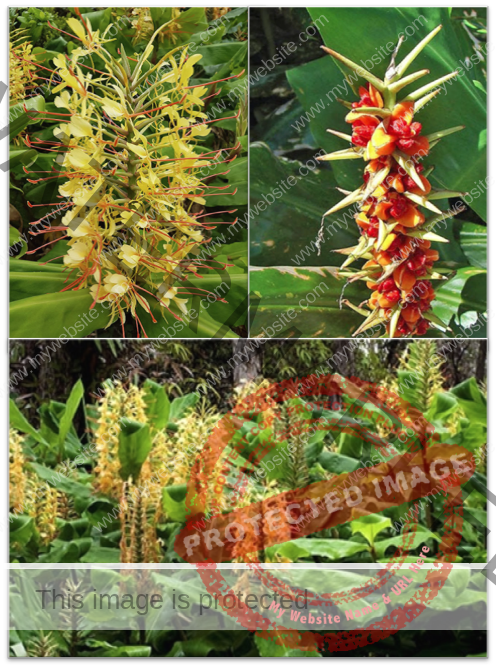
Weed of the Month: March
Kahili Ginger. Hedychium gardnerianum
Common name(s): Garland lily, Ginger lily
Kahili Ginger is a very attractive plant. Indeed, it has received the Royal Horticultural Society’s Award of Garden Merit. However, in subtropical and tropical environments it is causes serious problems.
Kahili ginger is a class 3 weed. This means landholders adjacent to environmentally significant areas must control this ginger on their property. It flowers from January through to March. Kahili ginger has lemon-yellow flowers with red stamens arranged as a spike 12 to 45 cm long. In time, its flowers turn into orange coloured seed pods which open to reveal bright red mature seed heads. It grows up to 2m tall.
Many ginger like plants reproduce by rhizome spread only. Kahili Ginger produces abundant seeds that are spread by birds and water. It quickly colonises the edge of rainforest and woodlands displacing native species. It is a serious escapee in Southeast Queensland.
Bright green leaves clasp 2m tall stems that emerge from underground rhizomes. The plant bears beautiful fragrant yellow and red flowers in dense spikes in late Summer-early Autumn. Red berries follow which hold black seeds that germinate freely.
Plants can be dug up in small to medium sized infestations, but the entire plant, including pieces of rhizomes need to be removed to avoid regrowth. This can be difficult and costly due to the deep, extensive rhizome system. Herbicide applications are recommended. Foliar spray, cut stump and basal bark applications can also be used to control ginger lily. Apply herbicides when the plants are actively growing. Best results are achieved during spring and summer months.
Click for more information about invasive plants and animals.

Australia Zoo Needs Help
Australia zoo needs help to supply enough Koala fodder to the zoo and animal hospital. Stocks are low and the leaf cutters are seeking new areas to harvest and are looking for willing landholders who have Eucalypt country to help out.
If you are able to assist, a representative from the zoo will come out and assess your site and let you know the process. Species the zoo is on the lookout for include (but not limited to):
- Eucalyptus propinqua
- Eucalyptus major
- Eucalyptus tereticornis
- Eucalyptus robusta
- Eucalyptus microcorys
- Some species of Spotted Gums and Ironbarks
If you are able to assist, please contact Dan on 0422 713 110.

Mapleton Lilyponds
Natural and artificial wetlands are indispensable for the countless benefits or ‘ecosystem services’ they provide humanity. Ecosystem services are goods and services from ecosystem structures and functions such as food, fibre and fuel and climate regulation. These various services for wetlands include the provision of freshwater resources, denitrification, carbon sequestration, flood mitigation, groundwater recharge and climate change regulation. Numerous studies show that wetland area and quality continue to decline in most regions of the world, including more developed parts of Australia.
The Mapleton Lilyponds precinct was for many years a natural spring-fed swamp. Thanks to the MADCA, community and council efforts over the years, these wetlands now provide habitat for flora and fauna, and their surrounds have been transformed into a place for families and visitors to the Blackall Range.

Koala Poo
Researchers are now seeking fresh koala scats from the public to map koala diet across Queensland.
It is estimated that there are probably be less than 60,000 Koalas remaining in Australia today and it could be as low as 33,000. Much of their habitat has already been lost.
An adult koala eats about 1/2 – 1 kilogram of leaves each night. Most of their time Koala’s sleep. This is because it requires a lot of energy to digest the toxic, fibrous, nutritionaly low diet. Sleeping is the best way to conserve energy.
In order to better understand what they eat, researchers at Western Sydney University and the University of Queensland have developed a genetic method that can identify what species they have eaten from their poo.
If you regularly see koalas in your area and can collect fresh scats from beneath their trees then please contact: Ben Moore (b.moore@westernsydney.edu.au) or Michaela Blyton (m.blyton@uq.edu.au). They will then send you out an information pack, sampling kit and return postage paid envelope for you to collect your samples.
All findings from the project will be made publicly available on the project website
Click for more information from whatdokoalaseat.org

Southern Pink Underwing Moth & Caronia Vine
Have you seen this vine?
During late spring, summer, and early autumn, keep an eye out for Carronia vine (carronia multisepalea) on your property. Carronia has indistinct small olive-coloured flowers, a straggly vine-like growth. Also, look for the characteristic elbowed leaf base and the oblong tough leaves. The female vines produce round fruit that ripen to a bright pink. The search is on for these fruit!
As the lowland forests remnants are removed, many plant species with specific roles also disappear and with them the insects that feed on them. Whilst Carronia is still found in decent numbers the fragmented nature of our forests has caused the decline of dependant species.
There is a conservation program underway for the endangered Southern Pink Underwing moth which feeds only on this vine and lives in shaded sub-tropical forest. The moth’s larva is one of the worlds most exotic looking larva and grows to 10-12cm long. Young caterpillars are dull brown. However, as they mature they develop a dramatic ‘head’ display when alarmed: two large ‘eye’ spots and a double row of white ‘teeth’. If frightened it folds its real head away and its top segments appear to lunge forward giving the impression of a small fleshy ‘monster’ about to bite you! The moth itself has bright pink underwings with white spots.
The Southern Pink Underwing Moth is distributed from Nambour in south-eastern Queensland to Bellingen in northern NSW
If you find any of these fruit, please contact: mark.runkovski@natura-pacific.com or phone 1300 318 720.

Weed of the month: December
Singapore Daisy.Sphagneticola trilobata
Common Name(s): Creeping oxeye, yellow dots, Biscayne creeping oxeye, rabbits’ paw.
Singapore daisy is a significant weed in Queensland. This means that it has been listed as a category 3 restricted invasive plant under the biosecurity act 2014. It cannot be given away, sold, or released into the environment. It is a creeping mat forming plant with yellow to orange daisy flowers. It spreads rapidly and smothers other plants. It flowers from spring to autumn.
It is a central American native but has spread around the Caribbean, tropical South America, and Australia. It is now classified as one of the worst invasive species in the world. It was originally introduced as a garden plant and sold through nurseries in Queensland.
Singapore daisy has hairy stems. The leaves are lush and glossy green with toothed margins. The underside of the leaf is paler. It produces yellow to orange flowers that are about 2-3cm wide above short stalks. Each flowers as between 8-13 petals. It forms roots at every node.
It seeds copiously and is spread rapidly by mowing and slashing when tiny stem fragments meet the soil and take root. The weed is hard to control. Hand pulling is possible, but it grows back easily. It can be controlled using herbicide.
To dispose of the weed, place it in a black plastic bag or container in the sun for several days. This will stop the roots from growing back. an
Click for more information about Singapore Daisy.
Click for more information about invasive plants and animals.